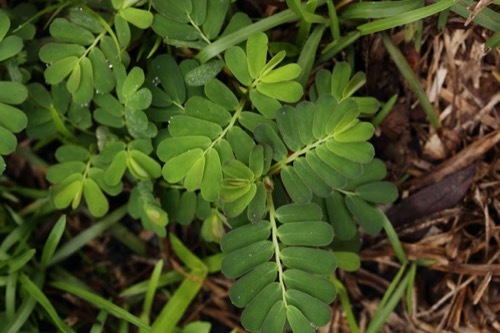Chamberbitter Preventers & Lawn Maintenance

Chamberbitter, also called Little Mimosa, is a fast-growing weed that can invade lawns in late spring and early summer.
If there are chamberbitter weeds growing in your area or if you have had chamber bitter in your lawn previously, there are several steps you can take to stop the weed from returning. Read below to learn more.
How To Apply a Chamberbitter Preventer
(Pre-Emergent Herbicide)
Chamberbitter preventer weed killers help prevent chamberbitter weeds from growing in your lawn by attacking and controlling the plants before they sprout through the surface. Because these unwanted weeds are most vulnerable when they are youngest, it is important to time your treatment correctly. Blocking any new growth of chamberbitter can help you keep your lawn weed-free.
- Pre-emergent herbicides must be applied before seeds begin to germinate. The germination timing of chamberbitter plants will vary depending on your location and climate, but germination will usually begin later in the spring or during the summer when soil temperatures reach 70 degrees F. Contact your local extension office for some tips on when to apply pre-emergents in your area.
- Chamberbitter is a rapidly-spreading and invasive weed, and there are only a few products labeled for chamberbitter control. The products listed below are our recommendations for pre-emergent chamberbitter prevention.
- Read the label and follow all instructions carefully. Some products are labeled for use only in warm-season grasses like Bermudagrass, Centipedegrass, St. Augustinegrass, and Zoysiagrass. Others are not labeled for use on residential turfs.
Products needed for Step 1
How To Maintain Your Lawn To Defend Against Chamberbitter

Chamberbitter weeds can grow easily in both shady and full-sun areas of your lawn or pasture. They favor warm soil and do well in humid areas. Chamberbitter seeds do need sunlight to germinate, and their cycle of life can be interrupted in landscaped beds by applying a layer of two to three inches of mulch in the springtime to block out the sun and starve the seeds underneath.
As with most other weeds, a strong defense against a chamberbitter weed infestation is to maintain a healthy lawn that is not distressed by drought, pests, or any lack of nutrients. Keep your lawn mowed to the proper height, as recommended for your turf type. Fertilize or add soil amendments where needed to maintain healthy soil. Observe your lawn closely to make sure there are no drainage issues or overly compacted soil. Aeration can help you improve your lawn's health if either of these conditions are observed.
Chamberbitter is rarely a welcome sight for anyone, but with some diligence and watchfulness in your lawn care routine, you can prevent new chamber bitter weeds popping up in your future.
If you have any questions about the methods discussed in these articles or the products needed to prevent and kill chamberbitter, give our lawn care experts a call at 866-581-7378 or email [email protected].





